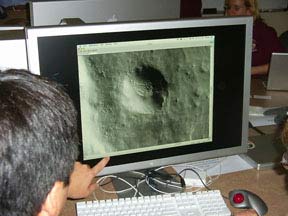First Images Beamed Back by Mars Probe

The first images from the High Resolution Imaging Experiment (HiRISE) aboard NASA's Mars Reconnaissance Orbiter (MRO) were returned to Earth early this morning to the delight of scientists waiting to see how the camera would perform.
Apparently it's working just fine.
"The first HiRISE images are in," wrote from the University of Arizona systems programmer Loretta McKibben in a blog early this morning. "And they are gorgeous! These images are sharp, clear and beautiful in the 'quick-look' or raw form."
"Incredible," said Candy Hansen, Deputy Principal Investigator for the project.
"I am VERY happy!" said from the University of Arizona researcher Alfred McEwen, chief scientist of the HiRISE camera. "They are sharp, clear, and beautiful!"
The pictures were taken late Thursday and are expected to be released by NASA today. SPACE.com will provide them upon release.
"We're seeing brand new details-things never seen before," said Chris Okubo, according to McKibben's blog.
Get the Space.com Newsletter
Breaking space news, the latest updates on rocket launches, skywatching events and more!
It takes about 13 minutes for data to reach Earth, traveling at the speed of light. That's because the spacecraft and Mars are 13 light-minutes from Earth, or about 145 million miles away. The probe launched on Aug. 12, 2005.
The camera will take a second set of Mars images Saturday morning, but those will be camera test images not expected to be as interesting to the public. HiRISE images taken during two orbits will be the camera's only photos for the next six months.
After the test shots, the camera will be turned off while the spacecraft "aerobrakes"-a process whereby MRO will repeatedly dip into Mars' upper atmosphere to circularize its orbit around the planet.
The orbiter carries six science instruments, including a radar device designed to probe the internal structure of Mars' polar ice caps, as well as to gather information planet-wide about underground layers of ice, rock and, perhaps, liquid water that might be accessible from the surface.
- Top 10 MRO Facts
- Getting There: MRO's Trip to Mars
- MRO Story Archive
Join our Space Forums to keep talking space on the latest missions, night sky and more! And if you have a news tip, correction or comment, let us know at: community@space.com.

Space.com is the premier source of space exploration, innovation and astronomy news, chronicling (and celebrating) humanity's ongoing expansion across the final frontier. Originally founded in 1999, Space.com is, and always has been, the passion of writers and editors who are space fans and also trained journalists. Our current news team consists of Editor-in-Chief Tariq Malik; Editor Hanneke Weitering, Senior Space Writer Mike Wall; Senior Writer Meghan Bartels; Senior Writer Chelsea Gohd, Senior Writer Tereza Pultarova and Staff Writer Alexander Cox, focusing on e-commerce. Senior Producer Steve Spaleta oversees our space videos, with Diana Whitcroft as our Social Media Editor.









